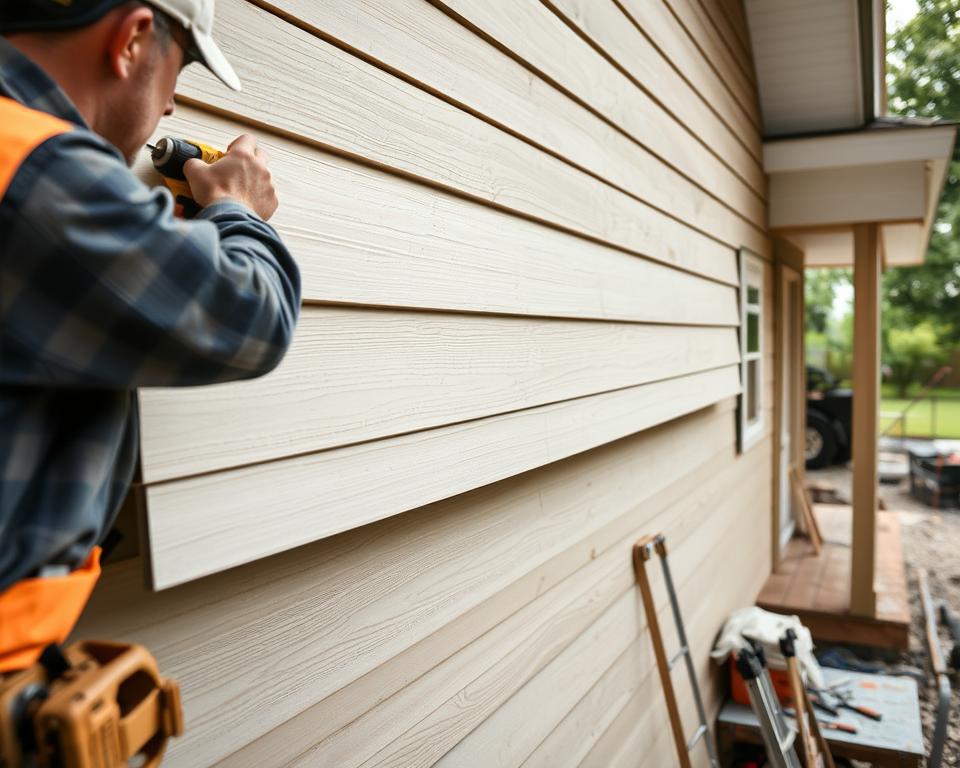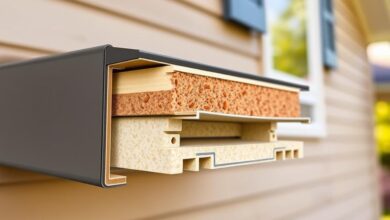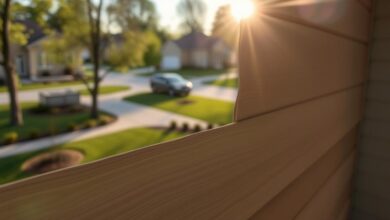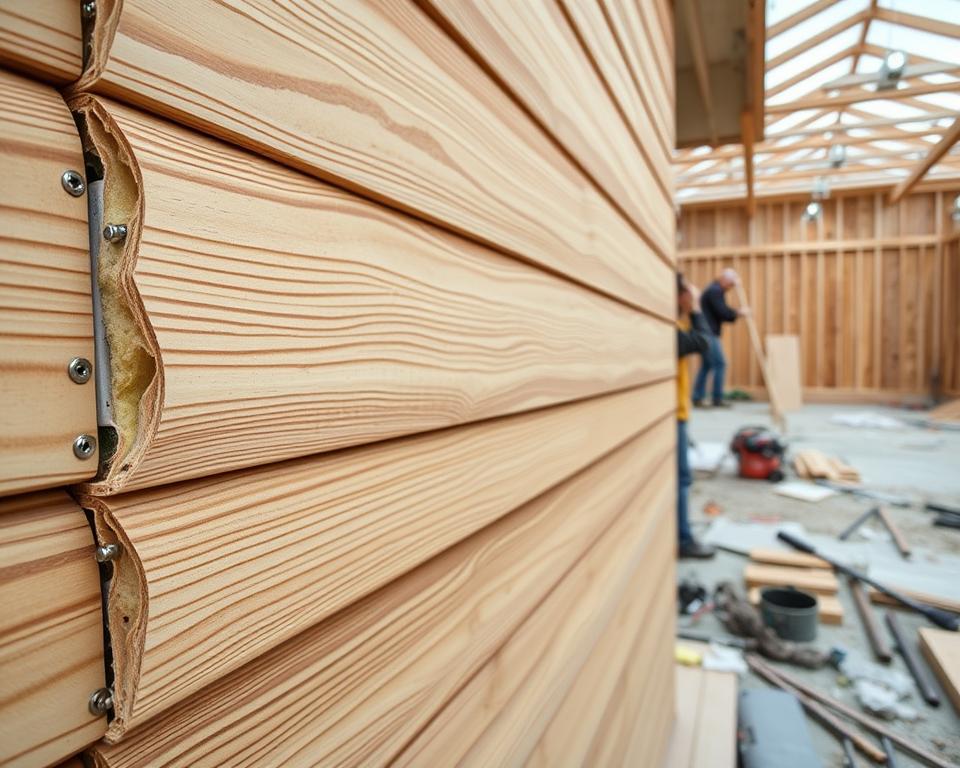Vinyl Insulated Siding: Protect Your Home in Style
Homeowners are choosing vinyl insulated siding to make their homes look better and save energy. This option not only makes your home look great but also lasts a long time. It’s easy to take care of, unlike some other siding types.
Adding vinyl insulated siding to your home is a smart move for any home renovation. It helps lower your energy bills and keeps your home safe from the weather. We’ll show you why it’s a good choice and how to put it on your house.
Key Takeaways
- Enhance your home’s curb appeal with vinyl insulated siding
- Improve energy efficiency and reduce energy costs
- Durable and low-maintenance solution for homeowners
- Comprehensive guide on installing vinyl insulated siding
- Boost your home’s protection against the elements
The Advantages of Vinyl Insulated Siding
Vinyl insulated siding combines durability, energy efficiency, and beauty. It’s a great choice for homeowners wanting to improve their home.
Energy Efficiency and Insulation Properties
Vinyl insulated siding seals your home tight. It keeps warmth in winter and cool in summer. This means lower energy bills and a cozy home.
The insulation in vinyl siding can cut energy use by up to 20%.
| Insulation Type | Energy Savings | Cost Efficiency |
|---|---|---|
| Vinyl Insulated Siding | Up to 20% | High |
| Traditional Siding | Less than 10% | Low |
Durability and Weather Resistance
Vinyl insulated siding can handle tough weather. It’s built to last, keeping your home looking good for years.
Key benefits include:
- Resistance to warping and cracking
- Ability to withstand extreme weather
- Low maintenance requirements
Style Options and Curb Appeal
Vinyl insulated siding comes in many styles and colors. You can find the perfect match for your home’s look. Whether you want modern or traditional, it boosts your home’s curb appeal.
Enhance your home’s exterior with the perfect blend of style and functionality.
Planning Your Siding Project
Planning well is key to a successful siding project. It affects everything from the start to how happy you’ll be with your home’s look.
Measuring Your Home’s Exterior
Getting the right measurements is vital for knowing how much siding you need. Start by figuring out your home’s total wall square footage. Measure each wall’s length and height, then multiply them. Remember to subtract the area of windows and doors.
If your home has different levels or unique designs, break it into sections. This makes it easier to figure out how much material you’ll need.
Selecting Colors and Styles
Picking the right color and style for your siding is important. Think about your home’s style, the area around it, and what looks good in your neighborhood. Neutral tones are often a good choice, but bold colors can stand out.
Also, pick a siding style that fits your home. Whether it’s horizontal, vertical, or a mix, it should look good and follow local rules.
Budgeting and Material Calculations
When budgeting for your siding project, remember it’s not just about the materials. Labor, permits, and any repairs to the structure can add up. Make a detailed budget to avoid unexpected costs.
| Component | Cost Estimate |
|---|---|
| Vinyl Insulated Siding | $3 – $5 per sq. ft. |
| Labor Costs | $2 – $4 per sq. ft. |
| Permits and Inspections | $100 – $500 |
By measuring your home right, choosing the right colors and styles, and budgeting well, you can have a siding project that boosts your home’s value and looks.
Essential Tools and Materials for Installing Vinyl Insulated Siding
To get a professional look with vinyl insulated siding, you need the right tools and materials. A good installation starts with careful planning and preparation.
Required Tools Checklist
Having the right tools is key for a smooth siding installation. Here are the essential tools:
- Utility knife
- Tape measure
- Level
- Pencil and marker
- Drill and bits
- Chalk line
- Snap lock punch
- Nail puller
- Hammer
Siding Materials and Components
The quality of siding materials affects the installation’s durability and look. Important components include:
| Material | Description |
|---|---|
| Vinyl Siding Panels | Main exterior covering |
| Insulation Backing | Provides thermal insulation |
| Starter Strips | Initial strip for siding installation |
| J-Channels | Used around windows and doors |
Safety Equipment and Precautions
Safety is a top concern during siding installation. You’ll need:
- Safety glasses
- Work gloves
- Steel-toed boots
- Ladder or scaffolding
- Hearing protection
Always follow manufacturer guidelines and local safety regulations to avoid risks.
Step-by-Step Installation Process
To get a professional look with vinyl insulated siding, follow this guide. Installing it is a detailed process that needs the right tools and attention.
1. Removing Existing Siding
The first step is to remove the old siding. Carefully pry it off without damaging the wall. Wear gloves and safety glasses to avoid injury.
2. Preparing the Wall Surface
After removing the old siding, check the wall for damage or rot. Fix any issues before moving on. Make sure the surface is clean and dry for the new siding. A clean surface is key for a good installation.

3. Installing Insulation Backing
Put in the insulation backing as the manufacturer says. This step boosts your home’s energy efficiency. The insulation backing reduces heat loss and can cut your energy costs. Installing it right is important for its benefits.
4. Attaching Starter Strips and J-Channels
Put starter strips along the wall’s bottom edge, making sure they’re level and tight. Use j-channels around windows and doors. These help the siding fit well and keep water out. Getting this step right is important for a good fit.
5. Mounting Vinyl Siding Panels
Start with the bottom panel and go up. Make sure each panel fits well and is nailed in place as the manufacturer says. Leave the right gap for expansion and contraction.
“The key to a successful vinyl insulated siding installation is attention to detail and adherence to the manufacturer’s instructions.”
6. Finishing Corners and Trim Work
Use corner posts and trim to finish the siding’s edges and corners. These add to the siding’s look and protect it from the weather. Make sure all trim is tight and sealed to keep water out.
By following these steps, homeowners can get a professional look with their vinyl insulated siding. Always check the manufacturer’s instructions and follow local building codes.
Maintenance and Care Tips for Vinyl Insulated Siding
Keeping your vinyl insulated siding in good shape is key. It keeps your home looking great and lasts longer. Regular care makes a big difference.
Seasonal Cleaning Methods
Cleaning your siding often is important. It gets rid of dirt, grime, and mildew. Use a soft brush or a low-pressure washer with a wide fan tip. High-pressure washes and harsh materials can harm the siding.
Recommended cleaning solution: Mix 1 cup of household bleach with 1 gallon of water. Use a soft-bristled brush to apply it to the siding. Then, rinse well with clean water.
Addressing Damage and Repairs
Check your siding often for damage like cracks, dents, or broken panels. Fixing these problems quickly stops more damage. It keeps your siding strong.
| Type of Damage | Repair Method |
|---|---|
| Cracks or small holes | Use a vinyl siding repair compound to fill the damaged area. |
| Broken or damaged panels | Replace the damaged panel with a new one, ensuring it is securely fastened. |
Preventing Mold and Mildew
Mold and mildew can grow in damp or shaded spots. Make sure your home gets good airflow. Also, trim trees or bushes that block sunlight.
Using bleach in your cleaning solution can stop mold and mildew. Regular checks and quick fixes keep your siding looking and working well.
Conclusion
Vinyl insulated siding is a smart choice for homeowners. It protects your home and makes it look better. Knowing its benefits, like saving energy and lasting long, helps you choose wisely for your home’s makeover.
Getting it right is key to enjoying vinyl insulated siding’s perks. Follow the steps and tips in this article. This way, you’ll get a great result that boosts your home’s value.
With the right tools and knowledge, you can make your home’s outside look great and work well. Vinyl insulated siding is perfect for updating your home’s look or saving on energy costs.








